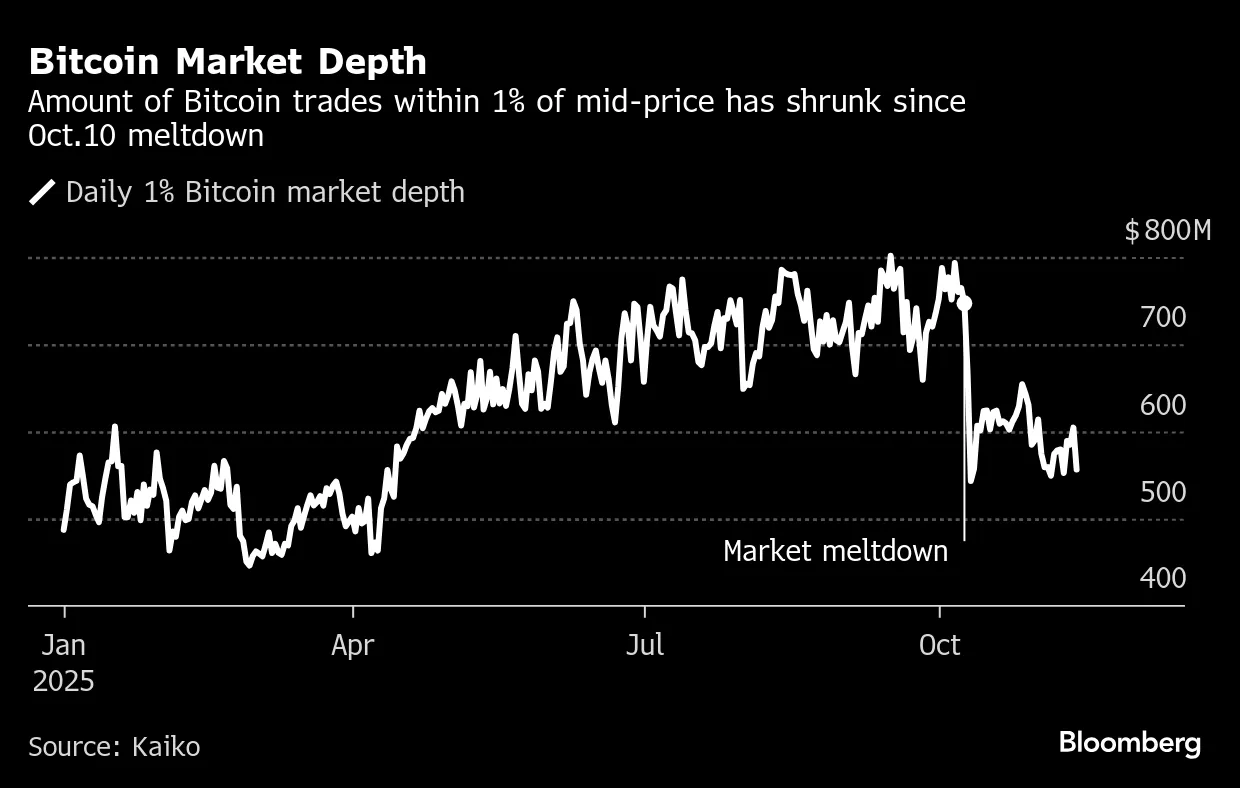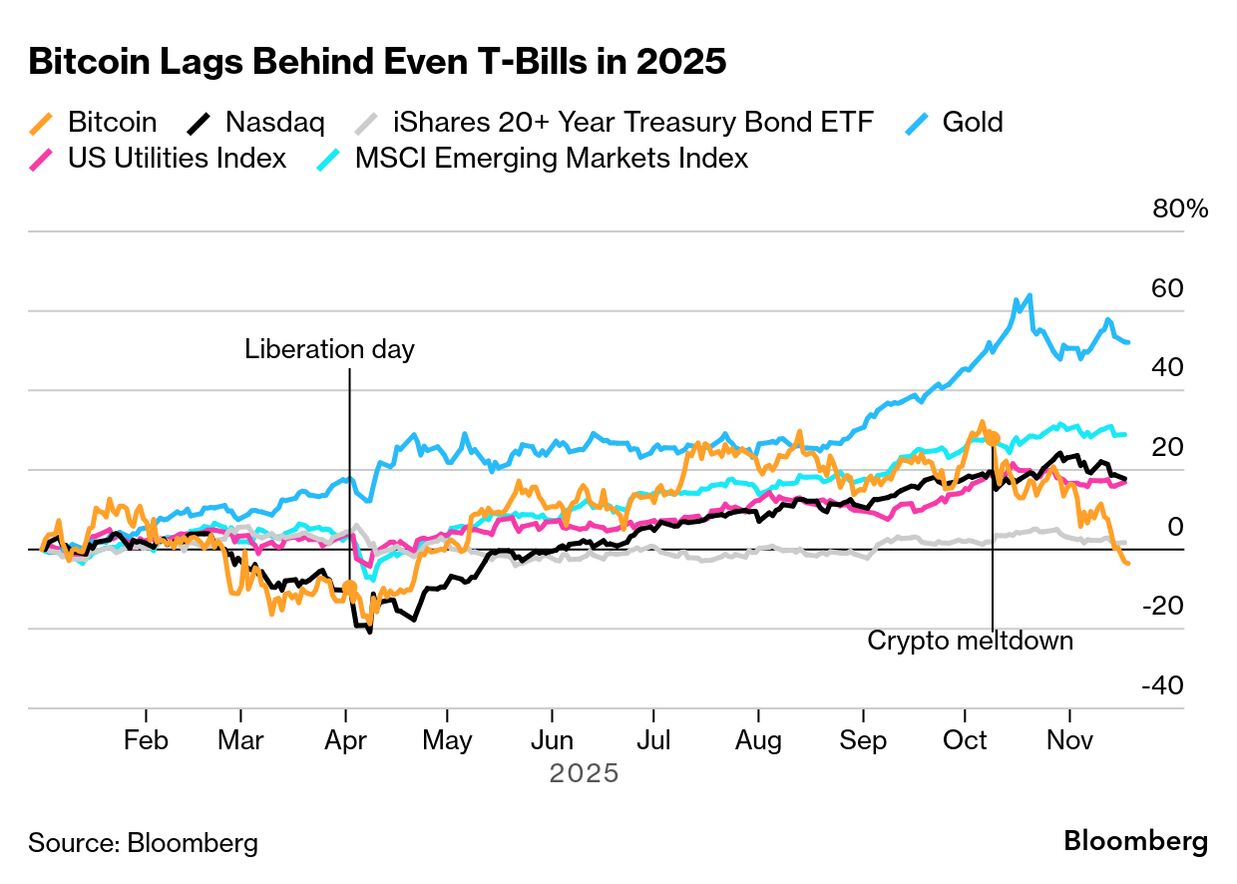Great Bitcoin Crash of 2025 Has It Lagging Bonds, Gold and More
TL;DR
Bitcoin has fallen nearly 30% in 2025, underperforming assets like gold, bonds, and tech stocks. It has failed as an inflation hedge and portfolio diversifier, with ETF investors now underwater. The crash is linked to market volatility and reduced liquidity.
Key Takeaways
- •Bitcoin has declined nearly 30% from its 2025 peak, lagging behind traditional assets such as Treasuries, gold, and tech stocks.
- •The cryptocurrency has not fulfilled its roles as an inflation hedge, growth engine, or uncorrelated store of value in recent times.
- •Market depth has shrunk, and ETF outflows continue, with investors seeking downside protection amid high volatility and low liquidity.
- •The October 2024 crash and broader economic factors, like weaker growth data and risk aversion, have contributed to Bitcoin's underperformance.
Tags

The asset once expected to “go to the moon” is struggling to keep pace with Treasuries. Bitcoin has fallen nearly 30% from its 2025 peak, lagging behind everything from tech stocks to T-bills.
Once promoted as a high-growth play, an inflation hedge, and a portfolio diversifier, the world’s largest cryptocurrency now faces the prospect of ending the year in the red — without fulfilling any of those roles.
Gold — often dismissed by Bitcoin believers as outdated — is easily outperforming the token, which the crypto faithful have dubbed digital gold. So are long-term bonds and the Nasdaq, in a year defined by falling interest rates and shrinking risk appetite.
The underperformance is even starker against benchmarks Bitcoin was supposed to outclass. The MSCI Emerging Markets Index is up sharply this year, and even the US Utilities Index — a byword for low-volatility, low-growth stability — has outpaced Bitcoin’s slide.

On Tuesday, Bitcoin briefly dipped below $90,000 — roughly the average entry price of all ETF inflows since their launch — meaning the typical ETF investor were now underwater. The largest cryptocurrency climbed off the seven-month low to trade about 1.5% higher to $93,241 as of 11:46 a.m. in New York.
For many, this was supposed to be crypto’s breakout year. A pro-crypto White House, new rules allowing launch of exchange-traded funds across tokens, and a wave of institutional inflows had seemingly secured digital assets a place in mainstream finance. Instead, for investors who bought near the highs, Bitcoin’s 2025 story feels familiar: a burst of euphoria, a crash, and growing disbelief.
Once pitched as everything from an inflation hedge to a growth engine and an uncorrelated store of value, the token has fallen short on every count of late. Volatile? Always. Reliable? Less and less.
That matters for professional investors. In diversified portfolios, Bitcoin has failed to offset losses from tariff-driven selloffs or amplify gains during rebounds. Nor has it acted independently when other markets turned volatile. For fund managers who saw crypto as a strategic addition, the disappointment goes beyond performance — it cuts to purpose.
Amount of Bitcoin trades within 1% of mid-price has shrunk since Oct.10 meltdown

Theories about what went wrong vary. Some blame October’s violent crash, which erased roughly $19 billion in leveraged positions and left deep psychological scars across the market. “10th October is definitely a longer lasting shock to the market than it appears on the surface,” said George Mandres, senior trader at XBTO Trading. “As much as market participants will try to forget or brush it off, it will remain deeply embedded in the appetite of market-makers to provide liquidity and in market participants’ conviction and risk appetite.”
Others point to broader market weakness. “Asia printed softer growth data overnight, Chinese equities weakened, and global tech valuations retreated as investors reassessed pricing ahead of Nvidia’s earnings on November 19,” said Timothy Misir, head of research at digital asset analytics firm BRN. “With liquidity conditions already thin, correlations snapped back to their high-beta defaults. Crypto traded not as a hedge, but as the most leveraged expression of macro tightening.”

“Talks of an incoming bear market are starting to ring louder and louder,” said Augustine Fan, director at SignalPlus.
Read more: Bitcoin ETF Investors in the Red After $89,600 Level Breaks
To be sure, Bitcoin still trades well above levels seen before Donald Trump’s re-election, and its history is filled with sharp declines followed by spectacular recoveries. Over longer horizons, returns remain impressive. But for now, traders are positioned defensively. Demand for downside protection around the $85,000 and $80,000 levels has surged, and options data suggest less than a 5% chance of Bitcoin revisiting its record high above $126,000 by year-end, according to data from Coinbase-owned Deribit.